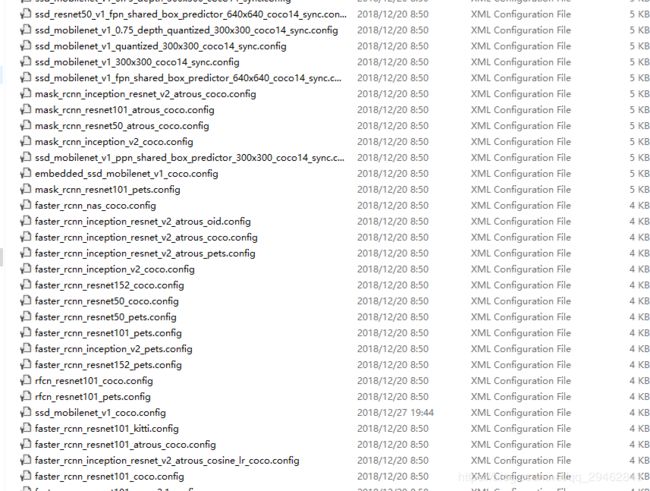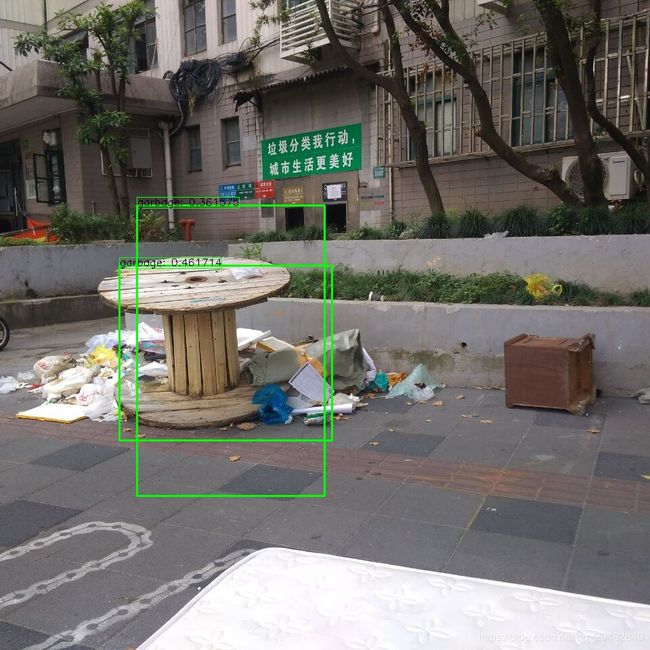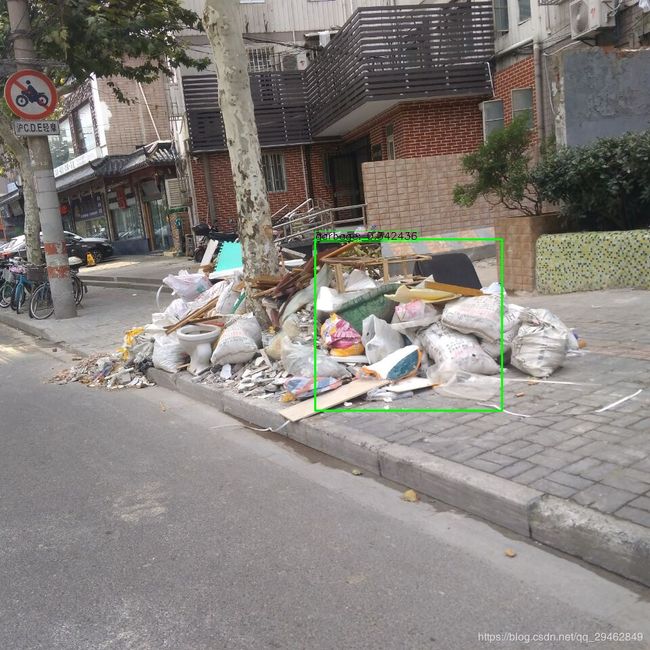tensorflow线下训练SSD深度学习物体检测模型,C++线上调用模型进行识别定位(干货满满)
一、介绍
近两年来出现了许多优秀的分类、物体检测和分割模型,包括SSD,yolo,Mask RCNN,这些模型速度快,准确率高,被广泛应用于无人驾驶、人脸定位识别、工业缺陷检测中。工业领域,系统一般基于C/C++,而这些模型基本都都是基于python的,那么如何把python训练的模型集成到C++中呢?Opencv搭了一个很好的桥梁。opencv4.0可以支持调用Mask RCNN、Faster RCNN、SSD、YOLO等模型。这样我们可以通过线下训练好这些模型,通过opencv把模型集成到系统中。
二、opencv调用模型
关于opencv如何调用深度学习模型请参考前面两篇博文:
https://blog.csdn.net/qq_29462849/article/details/85272575
https://blog.csdn.net/qq_29462849/article/details/85262609
opencv做了一个很好的tensorflow接口,这个时候就不得不提tensorflow object detection api,里面集成了SSD、Faster RCNN、Mask RCNN等多种模型,opencv和其无缝对接。
关于tensorflow object detection api的安装和配置请参考:
https://blog.csdn.net/zong596568821xp/article/details/82015126
https://blog.csdn.net/chuquanchang1051/article/details/79804965
如果在windows下配置时,出现缺少vc++14,那么下载安装即可。windows下如果proto成功了,但是安装不上,没关系,直接把整个object_detection模块拿来用就好。
三、训练数据
由于object detection api训练时采用的是tfrecords文件,所以需要进行转换,对voc数据来说,需要把xml文件转换成csv文件,源代码如下:
import os
import glob
import pandas as pd
import xml.etree.ElementTree as ET
def xml_to_csv(path):
xml_list = []
for xml_file in glob.glob(path + '/*.xml'):
tree = ET.parse(xml_file)
root = tree.getroot()
for member in root.findall('object'):
value = (root.find('filename').text,
int(root.find('size')[0].text),
int(root.find('size')[1].text),
member[0].text,
int(member[4][0].text),
int(member[4][1].text),
int(member[4][2].text),
int(member[4][3].text)
)
xml_list.append(value)
column_name = ['filename', 'width', 'height', 'class', 'xmin', 'ymin', 'xmax', 'ymax']
xml_df = pd.DataFrame(xml_list, columns=column_name)
return xml_df
def main():
image_path = os.path.join('./train_data/tank/test/', 'Annotations')
xml_df = xml_to_csv(image_path)
xml_df.to_csv('./train_data/tank/test/csv/test.csv', index=None)
print('Successfully converted xml to csv.')
main()
当把xml文件转换成csv文件后,需要对csv文件进行转换,生成最终得tfrecords文件,转换代码如下所示:
"""
Usage:
# From tensorflow/models/
# Create train data:
python generate_tfrecord.py --csv_input=data/train_labels.csv --output_path=train.record
# Create test data:
python generate_tfrecord.py --csv_input=data/test_labels.csv --output_path=test.record
"""
from __future__ import division
from __future__ import print_function
from __future__ import absolute_import
import os
import io
import pandas as pd
import tensorflow as tf
import sys
from PIL import Image
# sys.path.append("F:\setup\tf\models-master\research\object_detection")
from object_detection.utils import dataset_util
from collections import namedtuple, OrderedDict
flags = tf.app.flags
flags.DEFINE_string('csv_input', default='./train_data/tank/train/csv/train.csv',help='')
flags.DEFINE_string('output_path', default='./train_data/tank/train/tf_record/train.record',help='')
flags.DEFINE_string('image_dir', default='./train_data/tank/train/JPEGImages/',help='')
FLAGS = flags.FLAGS
# TO-DO replace this with label map
def class_text_to_int(row_label):
if row_label == 'tank':
return 1
elif row_label == 'white':
return 2
else:
return 0
def split(df, group):
data = namedtuple('data', ['filename', 'object'])
gb = df.groupby(group)
return [data(filename, gb.get_group(x)) for filename, x in zip(gb.groups.keys(), gb.groups)]
def create_tf_example(group, path):
with tf.gfile.GFile(os.path.join(path, '{}'.format(group.filename)), 'rb') as fid:
encoded_jpg = fid.read()
encoded_jpg_io = io.BytesIO(encoded_jpg)
image = Image.open(encoded_jpg_io)
width, height = image.size
filename = group.filename.encode('utf8')
image_format = b'jpg'
xmins = []
xmaxs = []
ymins = []
ymaxs = []
classes_text = []
classes = []
for index, row in group.object.iterrows():
xmins.append(row['xmin'] / width)
xmaxs.append(row['xmax'] / width)
ymins.append(row['ymin'] / height)
ymaxs.append(row['ymax'] / height)
classes_text.append(row['class'].encode('utf8'))
classes.append(class_text_to_int(row['class']))
tf_example = tf.train.Example(features=tf.train.Features(feature={
'image/height': dataset_util.int64_feature(height),
'image/width': dataset_util.int64_feature(width),
'image/filename': dataset_util.bytes_feature(filename),
'image/source_id': dataset_util.bytes_feature(filename),
'image/encoded': dataset_util.bytes_feature(encoded_jpg),
'image/format': dataset_util.bytes_feature(image_format),
'image/object/bbox/xmin': dataset_util.float_list_feature(xmins),
'image/object/bbox/xmax': dataset_util.float_list_feature(xmaxs),
'image/object/bbox/ymin': dataset_util.float_list_feature(ymins),
'image/object/bbox/ymax': dataset_util.float_list_feature(ymaxs),
'image/object/class/text': dataset_util.bytes_list_feature(classes_text),
'image/object/class/label': dataset_util.int64_list_feature(classes),
}))
return tf_example
def main(_):
writer = tf.python_io.TFRecordWriter(FLAGS.output_path)
path = os.path.join(FLAGS.image_dir)
examples = pd.read_csv(FLAGS.csv_input)
grouped = split(examples, 'filename')
for group in grouped:
tf_example = create_tf_example(group, path)
writer.write(tf_example.SerializeToString())
writer.close()
output_path = os.path.join(os.getcwd(), FLAGS.output_path)
print('Successfully created the TFRecords: {}'.format(output_path))
if __name__ == '__main__':
tf.app.run()
把数据准备好后,需要进行一些配置,主要是samples/config文件夹下面的.config文件。

这里以ssd_mobilenet_v1_coco.config为例,当使用这个模型时候需要首先下载预训练的一些参数,下载链接:模型。
更多模型请参考:model_zoo
需要对ssd_mobilenet_v1_coco.config进行修改,主要有num_class,batch_size,还有一些文件路径。
model {
ssd {
num_classes: 2 //几类物体就写几类
box_coder {
faster_rcnn_box_coder {
y_scale: 10.0
x_scale: 10.0
height_scale: 5.0
width_scale: 5.0
}
按照格式,改下路径即可。
fine_tune_checkpoint: "model_zoo/ssd_mobilenet_v1_coco_11_06_2017/model.ckpt"
from_detection_checkpoint: true
# Note: The below line limits the training process to 200K steps, which we
# empirically found to be sufficient enough to train the pets dataset. This
# effectively bypasses the learning rate schedule (the learning rate will
# never decay). Remove the below line to train indefinitely.
num_steps: 20000
data_augmentation_options {
random_horizontal_flip {
}
}
data_augmentation_options {
ssd_random_crop {
}
}
}
train_input_reader: {
tf_record_input_reader {
input_path: "train_data/train/tf_record/train.record"
}
label_map_path: "model_zoo/ssd_mobilenet_v1_coco_11_06_2017/object-detection.pbtxt"
}
eval_config: {
num_examples: 100
# Note: The below line limits the evaluation process to 10 evaluations.
# Remove the below line to evaluate indefinitely.
#max_evals: 10
}
eval_input_reader: {
tf_record_input_reader {
input_path: "train_data/test/tf_record/test.record"
}
label_map_path: "model_zoo/ssd_mobilenet_v1_coco_11_06_2017/object-detection.pbtxt"
shuffle: false
num_readers: 1
}
关于.pbtxt文件是自己建立的,格式如下所示:
item {
id: 1
name: 'tank'
}
item {
id: 2
name: 'white'
}
然后,找到train.py,配置好路径,可以训练了~~~
# Copyright 2017 The TensorFlow Authors. All Rights Reserved.
#
# Licensed under the Apache License, Version 2.0 (the "License");
# you may not use this file except in compliance with the License.
# You may obtain a copy of the License at
#
# http://www.apache.org/licenses/LICENSE-2.0
#
# Unless required by applicable law or agreed to in writing, software
# distributed under the License is distributed on an "AS IS" BASIS,
# WITHOUT WARRANTIES OR CONDITIONS OF ANY KIND, either express or implied.
# See the License for the specific language governing permissions and
# limitations under the License.
# ==============================================================================
r"""Training executable for detection models.
This executable is used to train DetectionModels. There are two ways of
configuring the training job:
1) A single pipeline_pb2.TrainEvalPipelineConfig configuration file
can be specified by --pipeline_config_path.
Example usage:
./train \
--logtostderr \
--train_dir=path/to/train_dir \
--pipeline_config_path=pipeline_config.pbtxt
2) Three configuration files can be provided: a model_pb2.DetectionModel
configuration file to define what type of DetectionModel is being trained, an
input_reader_pb2.InputReader file to specify what training data will be used and
a train_pb2.TrainConfig file to configure training parameters.
Example usage:
./train \
--logtostderr \
--train_dir=path/to/train_dir \
--model_config_path=model_config.pbtxt \
--train_config_path=train_config.pbtxt \
--input_config_path=train_input_config.pbtxt
"""
import functools
import json
import os
import tensorflow as tf
from object_detection.builders import dataset_builder
from object_detection.builders import graph_rewriter_builder
from object_detection.builders import model_builder
from object_detection.legacy import trainer
from object_detection.utils import config_util
tf.logging.set_verbosity(tf.logging.INFO)
flags = tf.app.flags
flags.DEFINE_string('master', '', 'Name of the TensorFlow master to use.')
flags.DEFINE_integer('task', 0, 'task id')
flags.DEFINE_integer('num_clones', 1, 'Number of clones to deploy per worker.')
flags.DEFINE_boolean('clone_on_cpu', False,
'Force clones to be deployed on CPU. Note that even if '
'set to False (allowing ops to run on gpu), some ops may '
'still be run on the CPU if they have no GPU kernel.')
flags.DEFINE_integer('worker_replicas', 1, 'Number of worker+trainer '
'replicas.')
flags.DEFINE_integer('ps_tasks', 0,
'Number of parameter server tasks. If None, does not use '
'a parameter server.')
flags.DEFINE_string('train_dir', default='training_model/tank/',help='')
flags.DEFINE_string('pipeline_config_path', default='samples/configs/ssd_mobilenet_v1_coco.config',help='')
flags.DEFINE_string('train_config_path', '',
'Path to a train_pb2.TrainConfig config file.')
flags.DEFINE_string('input_config_path', '',
'Path to an input_reader_pb2.InputReader config file.')
flags.DEFINE_string('model_config_path', '',
'Path to a model_pb2.DetectionModel config file.')
FLAGS = flags.FLAGS
@tf.contrib.framework.deprecated(None, 'Use object_detection/model_main.py.')
def main(_):
assert FLAGS.train_dir, '`train_dir` is missing.'
if FLAGS.task == 0: tf.gfile.MakeDirs(FLAGS.train_dir)
if FLAGS.pipeline_config_path:
configs = config_util.get_configs_from_pipeline_file(
FLAGS.pipeline_config_path)
if FLAGS.task == 0:
tf.gfile.Copy(FLAGS.pipeline_config_path,
os.path.join(FLAGS.train_dir, 'pipeline.config'),
overwrite=True)
else:
configs = config_util.get_configs_from_multiple_files(
model_config_path=FLAGS.model_config_path,
train_config_path=FLAGS.train_config_path,
train_input_config_path=FLAGS.input_config_path)
if FLAGS.task == 0:
for name, config in [('model.config', FLAGS.model_config_path),
('train.config', FLAGS.train_config_path),
('input.config', FLAGS.input_config_path)]:
tf.gfile.Copy(config, os.path.join(FLAGS.train_dir, name),
overwrite=True)
model_config = configs['model']
train_config = configs['train_config']
input_config = configs['train_input_config']
model_fn = functools.partial(
model_builder.build,
model_config=model_config,
is_training=True)
def get_next(config):
return dataset_builder.make_initializable_iterator(
dataset_builder.build(config)).get_next()
create_input_dict_fn = functools.partial(get_next, input_config)
env = json.loads(os.environ.get('TF_CONFIG', '{}'))
cluster_data = env.get('cluster', None)
cluster = tf.train.ClusterSpec(cluster_data) if cluster_data else None
task_data = env.get('task', None) or {'type': 'master', 'index': 0}
task_info = type('TaskSpec', (object,), task_data)
# Parameters for a single worker.
ps_tasks = 0
worker_replicas = 1
worker_job_name = 'lonely_worker'
task = 0
is_chief = True
master = ''
if cluster_data and 'worker' in cluster_data:
# Number of total worker replicas include "worker"s and the "master".
worker_replicas = len(cluster_data['worker']) + 1
if cluster_data and 'ps' in cluster_data:
ps_tasks = len(cluster_data['ps'])
if worker_replicas > 1 and ps_tasks < 1:
raise ValueError('At least 1 ps task is needed for distributed training.')
if worker_replicas >= 1 and ps_tasks > 0:
# Set up distributed training.
server = tf.train.Server(tf.train.ClusterSpec(cluster), protocol='grpc',
job_name=task_info.type,
task_index=task_info.index)
if task_info.type == 'ps':
server.join()
return
worker_job_name = '%s/task:%d' % (task_info.type, task_info.index)
task = task_info.index
is_chief = (task_info.type == 'master')
master = server.target
graph_rewriter_fn = None
if 'graph_rewriter_config' in configs:
graph_rewriter_fn = graph_rewriter_builder.build(
configs['graph_rewriter_config'], is_training=True)
trainer.train(
create_input_dict_fn,
model_fn,
train_config,
master,
task,
FLAGS.num_clones,
worker_replicas,
FLAGS.clone_on_cpu,
ps_tasks,
worker_job_name,
is_chief,
FLAGS.train_dir,
graph_hook_fn=graph_rewriter_fn)
if __name__ == '__main__':
tf.app.run()
训练好之后,需要把生成的模型转换为.pb模型,这时需要用到export_inference_graph.py。
import tensorflow as tf
from google.protobuf import text_format
from object_detection import exporter
from object_detection.protos import pipeline_pb2
slim = tf.contrib.slim
flags = tf.app.flags
flags.DEFINE_string('input_type', 'image_tensor', 'Type of input node. Can be '
'one of [`image_tensor`, `encoded_image_string_tensor`, '
'`tf_example`]')
flags.DEFINE_string('input_shape', None,
'If input_type is `image_tensor`, this can explicitly set '
'the shape of this input tensor to a fixed size. The '
'dimensions are to be provided as a comma-separated list '
'of integers. A value of -1 can be used for unknown '
'dimensions. If not specified, for an `image_tensor, the '
'default shape will be partially specified as '
'`[None, None, None, 3]`.')
flags.DEFINE_string('pipeline_config_path', 'samples/configs/ssd_mobilenet_v1_coco.config',
'Path to a pipeline_pb2.TrainEvalPipelineConfig config '
'file.')
flags.DEFINE_string('trained_checkpoint_prefix', 'training_model/tank/model.ckpt-7589',
'Path to trained checkpoint, typically of the form '
'path/to/model.ckpt')
flags.DEFINE_string('output_directory', 'pb_model/ssd_mobilenet_v1_coco_11_06_2017_tank', 'Path to write outputs.')
flags.DEFINE_string('config_override', '',
'pipeline_pb2.TrainEvalPipelineConfig '
'text proto to override pipeline_config_path.')
flags.DEFINE_boolean('write_inference_graph', False,
'If true, writes inference graph to disk.')
tf.app.flags.mark_flag_as_required('pipeline_config_path')
tf.app.flags.mark_flag_as_required('trained_checkpoint_prefix')
tf.app.flags.mark_flag_as_required('output_directory')
FLAGS = flags.FLAGS
def main(_):
pipeline_config = pipeline_pb2.TrainEvalPipelineConfig()
with tf.gfile.GFile(FLAGS.pipeline_config_path, 'r') as f:
text_format.Merge(f.read(), pipeline_config)
text_format.Merge(FLAGS.config_override, pipeline_config)
if FLAGS.input_shape:
input_shape = [
int(dim) if dim != '-1' else None
for dim in FLAGS.input_shape.split(',')
]
else:
input_shape = None
exporter.export_inference_graph(
FLAGS.input_type, pipeline_config, FLAGS.trained_checkpoint_prefix,
FLAGS.output_directory, input_shape=input_shape,
write_inference_graph=FLAGS.write_inference_graph)
if __name__ == '__main__':
tf.app.run()
转换成.pb模型之后,就可以使用opencv调用了~,opencv调用时,需要改下ssd_mobilenet_v1_coco.pbtxt对应的类别数,也就是真正的类别数+1,在最后几行。。。然后就可以调用了
opencv调用训练好的模型
请参考上两篇博文:
https://blog.csdn.net/qq_29462849/article/details/85272575
https://blog.csdn.net/qq_29462849/article/details/85262609
实验结果
说实话,SSD精度不算太高,下面开始尝试Faster RCNN。


